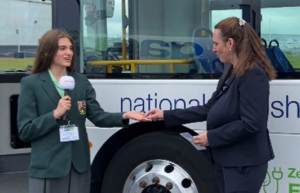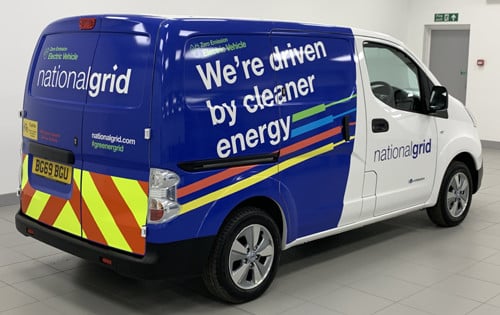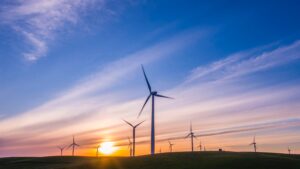
On the Journey to Zero podcast this week is the incredibly inspiring Lorna McAtear. Lorna is the Fleet Manager at National Grid, a winner of several awards (including EV Champion at Green Fleet Awards 2021, Green Fleet of the Year at Business Car Awards 2021 and Barbara Cox Award 2021), and an advocate for low and zero-emission vehicles.
As part of National Grid’s aim to reach net-zero by 2050, Lorna is working to ensure that all the company’s vehicles are fuelled by cleaner fuel sources by 2030.
I was honoured to get to speak to Lorna last month, and her positivity and enthusiasm about this movement is infectious. In a time when there is a lot of negativities posed about commercial vehicles and the damage they are doing to the environment, it was fantastic to hear a voice of hope and positivity who both celebrates commercial vehicles and has ambitious goals to help decarbonise them.
Listen to the full episode here:
Hannah: How did you get into the low/zero emission side of transport?
Lorna: It’s one of those things that snuck up on me without me even realising it was happening. I was always pushing ahead of the curve, even when I first started in fleet.
I put in my first five electric vans when I was still at EON, so we’re talking 10 years ago now. It was so good seeing the impact it had, seeing the positivity –in terms of people’s reaction to it, even back then.
When I moved over to the National Grid, I got an ‘EV Thank You’ card from Charlotte Smith. At the time, I didn’t know who she was, I didn’t know what she was doing. The card came to me at a time when I was really struggling with barriers and fighting my way through it. It brought me to tears. I just thought “This is why we do it.”

It gave me that motivation to get on with it.
H: What was it about the EV Thank You card that made you want to make a difference even more?
L: A child that I never met said “thank you for making a difference and thank you for helping me breathe easily.”
So, it was just realising that you are touching people you’ve never met, and they are appreciating what you’re doing.
Even if you’re struggling in your own work environment; struggling with that driver that doesn’t want to change, or struggling with getting it over the line with your board or execs. Whatever it is, there was a child out there that is thanking you.
H: What challenges do you face today?
L: Perception has changed a lot over the last 10 years, with the introduction of clean air zones and events like COP26 making business buy-in to these new technologies easier. However, there are still barriers in terms of the way that not every vehicle has a solution. So, how do you overcome that, especially when you’ve put a strategy into place?
But if you can’t get hold of certain vehicles, for example we’ve all got a problem with lack of semi-conductors at the minute, so vehicles are hard to get hold of. But do you know what? I’ll focus on the infrastructure for the time being instead, because I can do the infrastructure. Then I’ll be ahead of the curve for when those vehicles do come in.
It’s a case of working out what you can move within your strategy. If you can’t do that bit today, then do something else. It’s about controlling what you can control.
H: Is having a net-zero strategy something that is important for business?
L: Absolutely, you need a target. You need a vision. You need somewhere to aim.
So, back in January 2020, I set my strategy. I set it to be net-zero by 2030.
Then it’s a case of working backward from that date, thinking about all the different departments that will need to be involved.
And then you control what you can control. It’s like a jigsaw. You start with the most obvious changes, your quick wins: your pool vehicles, that one person who is really passionate and has been screaming at you; commercial vans that only do small mileages.
You understand what your fleet is, what its operation is, how those vehicles are used, jobs, and the people that are involved in it. As you go through it, your jigsaw starts to build up and as you work your way through that, you know where you’re going and you know roughly how you’re doing it, and you’ll get there. You’ll end up with a nice pretty picture at the end.

H: What can we do to decarbonise our bigger vehicles?
L: Let’s think about where we were five years ago, we didn’t have anywhere near the amount of choice that we do today. It was always on the horizon, and it never actually materialised.
But what’s happened in the last five years, or even two years, we have every vehicle manufacturer moving over to electric cars.
Vans have always historically been two to three years behind cars, so the vans we’re starting to see make a breakthrough. At the start of the pandemic, we had a handful of vans on the market, now we have 20 – 30 vans in that van sector.
As you move up and get towards the heavies, there are so many different types of HGVs. What I mean by that is that you have the lorries that trunk up and down the UK, then you have more specialised HGVs, local councils, local deliveries, urban deliveries, fridge vehicles, and much more. Some things are moving quicker than others.
It was amusing to see Renault Truck ZE’s tour of the country LinkedIn posts because they’d taken up all the charging bays because there’s nowhere for trucks to charge up. But, they’d proved the concept.
There are also lots of big trials going on. There are trials happening with the overhead catenary system (like tram systems but for trucks), you’ve got the hydrogen trials and then you’ve also got your interim solutions as well. So, your biomethane (CNG, LNG) and your other biodiesels.
We realise we can’t get to the ultimate solution yet, but we’ve got a pathway of 10 – 15 years, so if I can use the biofuels at least I’m doing better than what I’m doing already.
In two years’ time, it will be very different again. And in another two years, it will be different yet again. It’s moving so fast. It’s just a case of keeping an eye on what’s out there, how are the trials working out and also doing your own trials.
H: Do we have enough electricity in the UK to power all these new ideas and new technology that is coming along?
L: The very quick short answer is always: yes.
National Grid is the transmission system. We don’t make it, we don’t buy it, we don’t sell it – we just move it around the country.
There is investment going in, and we aim to have 40 giga watts of electricity produced by renewables by 2030.
Back in 2012, we hit our peak on the grid. Ever since then, the products we’ve used have become much more efficient. We’ve never got anywhere near that since.
Even if you put all the cars on it today, you still wouldn’t hit that peak. If we managed it then (in 2012), we can certainly manage it now.
Basically, there’s enough electricity there.
And we will keep investing. There will be more wind farms, there will be more solar farms. We’ve seen more renewables go in in the last year than we have the past five years.

It’s constantly evolving, and the grid is constantly getting cleaner.
H: What do you hope transport is going to look like in the future?
L: The pace of change is phenomenal. I think, for me, rather than what it’s going to look like, I have been so impressed with the amount of collaboration that is going on. I see this collaboration continuing. The work between the transport, digital and energy sectors really moving at pace.
What I see transport doing is leading the way for the other industries. I see the lessons being learnt here and all those transferable skills moving over to aviation, the maritime side of things.
It will be clean. It will be zero.
“It’s an obstacle course, and we only win when we all get over those obstacles and cross that line together”
For more information about Lorna and her work at National Grid and their low/zero emission fleet, you can follow her on LinkedIn and keep up to date with National Grid’s fleet on their website: nationalgrid.com/stories
For anything relating Charlotte Smith’s ‘EV Thank You’ card mission, find her on LinkedIn and YouTube. You can also help support her Children’s Clean Air campaign via Go Fund Me.
To find out more about alternative fuels, eHighways, and the effect of tyre dust, you can listen to our other podcast episodes via Spotify, Google Podcasts, or Anchor. Happy listening!